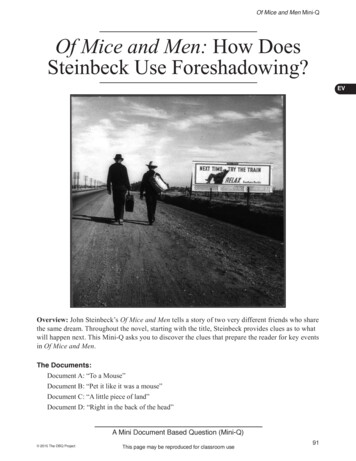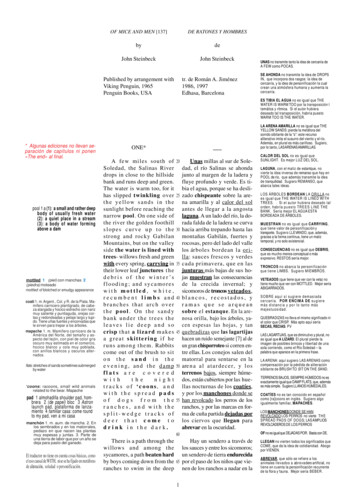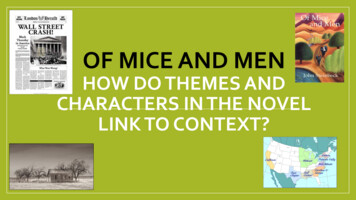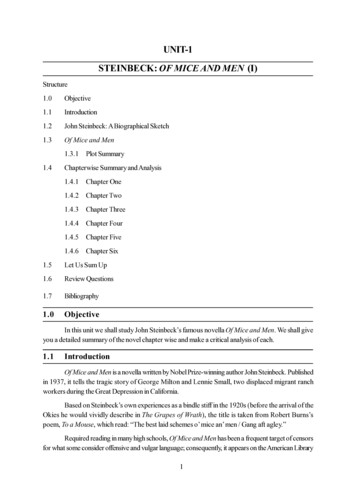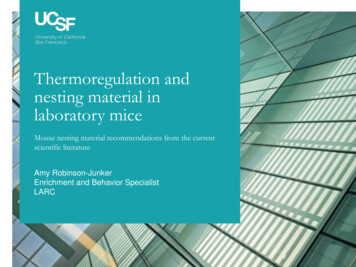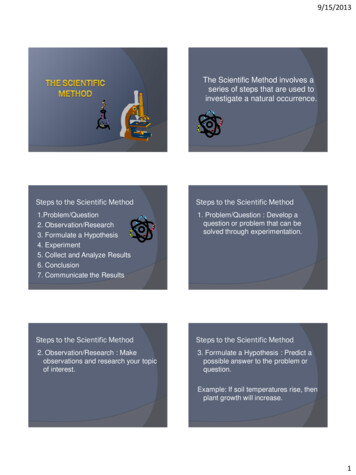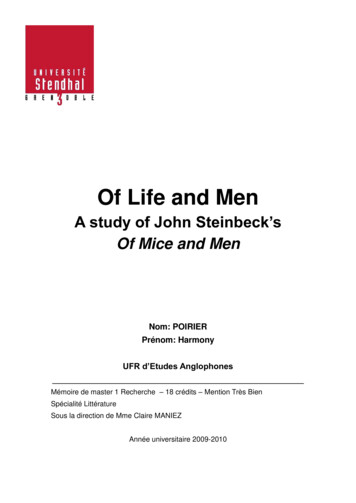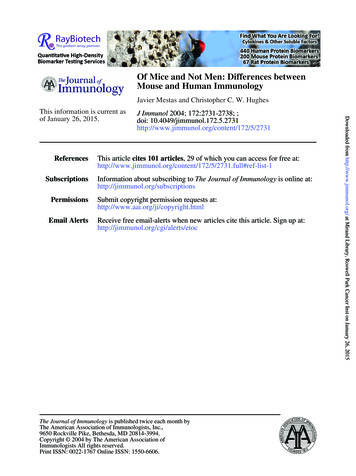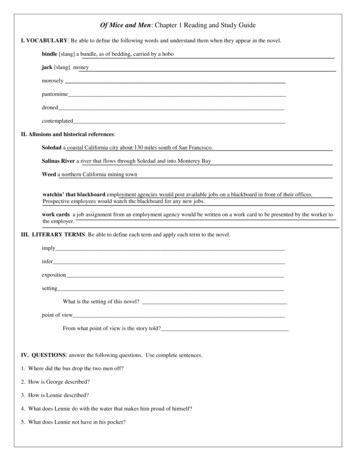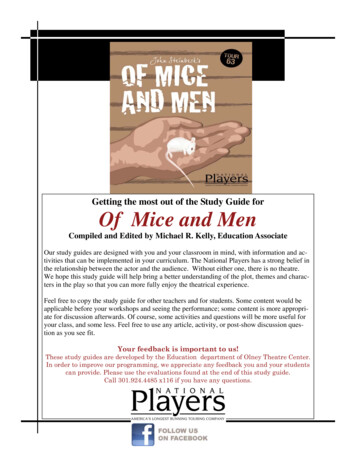
Transcription
Getting the most out of the Study Guide forOf Mice and MenCompiled and Edited by Michael R. Kelly, Education AssociateOur study guides are designed with you and your classroom in mind, with information and activities that can be implemented in your curriculum. The National Players has a strong belief inthe relationship between the actor and the audience. Without either one, there is no theatre.We hope this study guide will help bring a better understanding of the plot, themes and characters in the play so that you can more fully enjoy the theatrical experience.Feel free to copy the study guide for other teachers and for students. Some content would beapplicable before your workshops and seeing the performance; some content is more appropriate for discussion afterwards. Of course, some activities and questions will be more useful foryour class, and some less. Feel free to use any article, activity, or post-show discussion question as you see fit.Your feedback is important to us!These study guides are developed by the Education department of Olney Theatre Center.In order to improve our programming, we appreciate any feedback you and your studentscan provide. Please use the evaluations found at the end of this study guide.Call 301.924.4485 x116 if you have any questions.
Table of ContentsBefore/After the PerformanceMaryland Learning Goals andOutcomesRole of the AudienceThe CharactersPlot SynopsisDirector’s NotesPlaywright BiographyAdaptation to the StageHistory/Major Events-1937Themes and MotifsPlay’s Inspiration– poemCharacter ArchetypeVocabulary ListFurther Reading/ResearchDiscussion QuestionsTeacher EvaluationStudent Evaluation22345789101112131414151618America's Longest Running Touring CompanyThe National Players has earned a distinctive place in Americantheatre by bringing innovative and accessible productions toaudiences across the country. Performed with high-voltage energy, clarity, and wit, the National Players introduces audiencesto great works of dramatic literature that are rich in excitingstories and characters, and profound in language and themes.Our productions touch hearts and minds, inspire imaginationand wonder, spark curiosity about the self, the world, and thecreative process, and celebrate what it means to be human.The National Players was founded in 1949 by Father Gilbert V.Hartke, a prominent arts educator and head of the drama department at Catholic University of America. His mission – tostimulate young people’s higher thinking skills and imaginations by presenting classical plays in surprisingly accessibleways – is as urgent and vital today as it was 63 years ago.National Players offers an exemplary lesson in collaborationand teamwork-in-action: the actors not only play multiple rolesonstage, but also serve as managers, teaching artists, and technicians. A self-contained company, National Players carries itsown sets, lights, costumes, and sound.Before the PerformanceUsing the articles found in this study guide, students willbe more engaged in the performance. The guide will helpyou spot useful information in the show. In addition, theguide also contains articles on the various theatrical adaptations and movies inspired by Shakespeare’s work. This,combined with our in-classroom workshops, will keep thestudents attentive and make the performance an activelearning experience.After the PerformanceWith the play as a reference point, our questions and activities can be incorporated into your classroom discussions and can enable students to develop their higher levelthinking skills. Our materials address Maryland CoreLearning Goals, which are listed on the next page.The study guide addresses specific MarylandCore Learning Goals in English and EssentialLearning Outcomes in Theatre.Goal 1 Reading, Reviewing and Responding toTexts1.1.4 The student will apply reading strategies when comparing, making connections, and drawing conclusionsabout non-print text.1.2.1 The student will consider the contributions of plot,character, setting, conflict, and point of viewwhen constructing the meaning of a text.1.2.2 The student will determine how the speaker, organization, sentence structure, word choice, tone, rhythm, andimagery reveal an author’s purpose.1.2.3 The student will explain the effectiveness of stylisticelements in a text that communicate anauthor's purpose.1.2.5 The student will extend or further develop meaningby explaining the implications of the textfor the reader or contemporary society.1.3.4 The student will explain how devices such as staging, lighting, blocking, special effects, graphics, language,and other techniques unique to a non-print medium areused to create meaning and evoke response.1.3.5 The student will explain how common and universalexperiences serve as the source of literary themes thatcross time and cultures.
Goal 2 Composing in a Variety of Modes2.1.2 The student will compose to describe, usingprose and/or poetic forms.2.1.3 The student will compose to express personal ideas,using prose and/or poetic forms.Goal 4 Evaluating the Content, Organization, andLanguage Use of Texts4.1.1 The student will state and explain a personal responseto a given text.4.2.2 The student will explain how the specific languageand expression used by the writer or speaker affects readeror listener response.4.3.1 The student will alter the tone of a text byrevising its diction.4.3.3 The student will alter a text to present the samecontent to a different audience via the same or differentmedia.Study dramatic texts and, using improvisational skills,create extensions appropriate for identified charactersand situations.Outcome IV: Aesthetic Criticism- Use prescribed and self-constructed criteria to evaluate and describe verbally the characteristics of successful ensemble performances and productions.- Analyze dramatic texts and other literature of theatreto identify and describe the presence of theatrical conventions that influence performance.- Identify and describe verbally the primary scenic,auditory, and other physical characteristics of selectedtheatrical performances.- Write critical reviews of selected theatre performancesusing established criteria and appropriate language forthe art form.The Role of the AudienceOutcome 1: Perceiving, Performing and Responding—Aesthetic Education- Identify a wide variety of characters presented in dramatic The audience plays an integral role in every live performance, and especially in National Players shows.literature and describe ways they reflect a range of humanThe audience is, in fact, a key element in making livefeelings and experiences.theatre such a special medium and so different fromtelevision and film. During a live performance, pleaseOutcome II: Historical, Cultural, and Social Context- Demonstrate knowledge of appropriate audience behavior keep in mind that the actors onstage can both see andhear the audience, and while actors enjoy listening to thein relationship to cultural traditions.audience react, talking- Select and discuss the work of a variety of playwrights,and making loud comments only serves to distract accritics, theatre commentators, and theorists that representtors and fellow audience members.various cultures and historical periods.- Demonstrate familiarity with a variety of dramatic textsSo please watch the show, let the story move you inand genres.whatever way is true to you. Laugh if you want to- Compare the treatment of similar themes in drama fromlaugh; be afraid, intrigued, shocked, confused or horrivarious cultures and historical periods.fied. The actors want you to be involved in the storythey are telling. But please be respectful of the actorsOutcome III: Creative Expression and Production- Construct imaginative scripts and collaborate with actors working hard to bring you a live performance and to theaudience around you trying to enjoy the play.to refine scripts so the stories and their meaning areconveyed to an audience.- Develop multiple interpretations for scripts and visual andoral production ideas for presentations.- Create and project subtleties of character motivation andbehavior using speech, sound, and movement.
The Characters of Of Mice and MenGeorge Milton: a small, sharp-witted migrant worker/ranchhand that travels with Lennie. George is a typical, realistichand who uses his mind to anticipate the future and keepLennie in line.Lennie Small: a physically large and strong man whosemind is slow. He has a short attention span and acts similarto a child; because of his mental limitations, Lennie neverreally understands or anticipates the consequences of hisactions. He travels with and is looked after by his friendGeorge.The Boss: he is the superintendent of the ranch and overseesits day-to-day operations, but a big land corporation ownsthe ranch itself. He is a generally nice person that treats hisworkers nicely if they work hard, but he is a no-nonsensebusinessman when it comes to getting the grain out.Slim: he is a tall, well-respected mule driver (jerk-lineskinner) that is looked up to as a leader among theother ranch hands.He treats his work and everyone on the ranch with equalrespect, a hard and honest worker, and he knows how to dohis work without being told.Curley’s Wife; costume design by Ivania StackCrooks: he was given the nickname for his crooked backwhere a horse kicked him. He is a proud and independentAfrican American who also is an outcast on the ranch. He isbitter against the racial discrimination against him on theranch, but Lennie and Crooks come to be friends later on.He also wants to join Lennie and George's dream of havinghis own land.Carlson: he is ranch hand who is the opposite of Slim:coarse and insensitive to the other ranch hands, he onlycares about what is best for him. He is the true stereotype of Curley: he is the short-tempered son of the Boss and ahow migrant workers act and behave.former boxer. He is small in stature but he picks fights withthose weaker than he is and attempts to intimidate thoseCandy: the ranch worker that lost his hand on the job a few larger than him. He is also recently married, so he isyears back, he wants to join the George and Lennie in their constantly thinking about his wife on the ranch as well.dream of owning their own land by providing them with adown payment. Candy's one faithful companion is his olddog, who is about as useless as Candy is at the ranch.Whit: a young ranch hand that is like the younger brother ofthe bunkhouse. He relates easily to Candy and his dog, andis quick to making new friends out of the men that arrive atthe ranch.Curley's Wife: she is the only woman on the ranch and alsoin the play. She is continually around the ranch handsclaiming that she “is looking for Curley,” but she is alsoremarkably lonely in her new life on the ranch and justwants to talk with someone. She is pretty, if not excessivelyso, in order to get attention.(Left) Crooks; costume design by Ivania Stack
Plot SynopsisThe play begins with two traveling farm laborers, named George Milton and Lennie Small, on their wayto a job loading (bucking) barley at a California ranch. It is a Thursday evening, and they spend the night alongthe banks of Salinas River before arriving at the ranch the next morning. In this scene the audience discovers themain personality differences between George and Lennie.Lennie is slow mentally, and George acts as Lennie'sguardian, watching out for his friend. They've been traveling and working together for a long time, since Lennie'sAunt Clara passed away. George also continually mentions that Lennie's habit of petting soft things, such as adead mouse or the dress of a woman, often gets them intotrouble - forcing the two men to continuously look fornew jobs. They can never really settle down in one areadue to this, and also that Lennie doesn’t understand thedanger of his own great strength. They dream about owning their own place and being their own bosses in the nearfuture as they fall asleep.Upon arriving at the ranch Friday morning, theymeet an old man named Candy, who lost his hand at theranch a few years back. Candy explains to them the waysof the ranch and the manners of the other ranch hands.The Boss enters the bunkhouse to visit with his newworkers and is quite angry that they arrived late for themorning shift. He questions both George and Lennieabout their previous work experience, but eventually takesthem on and writes them into his work notebook. Curley,the Boss’ son, enters soon after looking for his father. Heis a former boxer of short stature and has a quick temper.He confronts George and Lennie about arriving late, andeven goes to threaten them with physical violence, butleaves the bunkhouse.(L-R) Michael Pettey(George) and Mat Leonard (Lennie). Photo by Madeleine RussellCurley's Wife enters the bunkhouse right before the ranch hands arrive for lunch. She claims she is"looking for her husband" and is a very attractive woman, but all the men avoid her since she just marriedCurley two weeks prior to the start of the play and they are wary of Curley’s temper. George warns Lennie tostay away from her, and Lennie tells George that he wants to leave this scary working environment. Slim, amule driver (jerk-line skinner), enters and introduces himself to George and Lennie. Another mule driver by thename of Carlson enters soon after and finds out from Slim that his dog has had puppies. Carlson discusses withSlim the idea of killing Candy's old dog and replacing it with one of his puppies because its smell makes it impossible to sleep in the bunkhouse. As the ranch hands leave to have their lunch, George agrees to ask Slim ifLennie can have a puppy.Later that evening, George confides in Slim his relationship with Lennie and thanks him for giving Lennie a puppy. He admits that Lennie isn't bright, but obviously a nice person and a hard worker. Carlson entersfrom playing horseshoes and pressures Candy to allow him to kill his dog in order to put it out of its misery.Candy gives in when Slim joins in the argument. Later in the scene, he overhears George and Lennie talkingabout their dream and asks to be part of it, offering to advance half of the money they need. Finally, their dreamappears within reach.
Slim left the bunkhouse to fix one of his mules’ hooves in the barn, and Curley enters looking for hiswife, and then leaves suspecting she is in the barn with Slim. Some of the other ranch hands follow thinkingthey are going to see a fight between the two men. They all return to the bunkhouse with Curley and Slim in averbal argument. Curley is taunted by the other men and is pushed to a boiling point, and he takes out his aggression on Lennie by first taunting him and then beating him up like a punching bag. Lennie takes this abuseuntil George tells him to “get him,” where he grabs Curley’s hand and breaks all the bones in it. Curley istaken to the doctor and George and Lennie are left wondering whether they will be fired or not.The next night, Saturday evening, George and most of the other ranch hands are off in town, whileLennie explores the barn after playing with his puppy and comesacross Crook’s room. At first, Crooks objects to this invasion of privacy, but eventually Lennie wins him over. Crooks describes thedifficulties of his life at the ranch, while Lennie speaks of the dreamthat he, George, and Candy share. Candy enters and tells Lenniethat he has been figuring out how to make the dream a reality ontheir ranch. Crooks asks if he can join them, and George enters theroom to find that they have been spreading their secret dreamaround. Curley's wife, looking for company, enters the room. All themen except Lennie argue with her, but she plays up to Lennie. Thescene ends with the Boss entering in on Curley’s Wife being in aroom alone with the four men.(L-R) Mat Leonard (Lennie) and Alex Highsmith (Curley’s Wife. Photo byMadeleine RussellThe next afternoon, Sunday, Lennie is alone in the barn while themen play horseshoes outside. By handling his puppy too much hehas broken its neck and as he tries to hide the animal, Curley's wifeenters. She talks to Lennie about her life, seemingly opening up hertroubled past to him. When she learns of Lennie's love for softthings, she invites him to touch her hair. He does so, but he holds ontoo tight, frightening Curley’s Wife and causing her to struggleabout. Lennie panics and accidentally breaks her neck, and flees tothe riverbank of the first scene where George told him to go in caseof trouble. Candy enters to find the woman's body. He gets Georgeand asks for reassurance that their dream will still be fulfilled, evenwithout Lennie. But George has already forsaken the vision with this crushing discovery. He asks Candy togive him a few minutes head start before telling the others so they won’t think he was involved in the incident.George reenters the barn with the others to discover the body and he attempts to convince the men that Lennieshould only be put away because he meant no harm. However, Curley insists on lynching him and they all goout to look for Lennie.That evening, Sunday night, Lennie makes his way back to the riverbank where the play began. Georgeenters to hide him in the brush as the men trail closely behind him. Slim persuades the group to spread outaway from the area in order to give George and Lennie some time. They exit, and Lennie asks George if hewill “give him hell,” but George does so halfheartedly. They discuss their dream one last time as George hasLennie look across the river to imagine the land they will eventually have. As Lennie finally pictures the land,George shoots him in the back of the head with the gun he stole from Carlson.
(L-R) Michael Pettey (George) and Mat Leonard (Lennie). Photo by Madeleine RussellDirector’s Notes – Of Mice and Men“It is one of the paradoxes of Truth that we gain by giving up; we lose by greedily grasping.Every gain in virtue necessitates some loss in vice; every accession of holiness means someselfish pleasure yielded up; and every forward step on the path to Truth demands the forfeit ofsome self-assertive error. He who would be clothed in new garments must first cast away theold, and he who would find the True must sacrifice the false. The gardener digs in the weeds inorder that they may feed, with their decay, the plants which are good for food; and the Tree ofWisdom can only flourish on the compost of uprooted follies. Growth/gain necessitates sacrifice/loss.”- James Allen“It is this Compassion alone which is the real basis of all voluntary justice and all genuine loving-kindness. Only so far as an action springs therefrom, has it moral value; and all conductthat proceeds from any other motive whatever has none. When once compassion is stirredwithin me, by another's pain, then his weal and woe go straight to my heart, exactly in the sameway, if not always to the same degree, as otherwise I feel only my own. Consequently the difference between myself and him is no longer an absolute one. No doubt this operation is astonishing, indeed hardly comprehensible. It is, in fact, the great mystery of Ethics.”- Arthur Schopenhauer“It has always seemed strange to me. the things we admire in men, kindness and generosity,openness, honesty, understanding and feeling, are the concomitants of failure in our system.And those traits we detest, sharpness, greed, acquisitiveness, meanness, egotism and selfinterest, are the traits of success. And while men admire the quality of the first they love theproduce of the second.”- John SteinbeckJason King Jones, director
Playwright’s Biography– John SteinbeckJohn Steinbeck was born in Salinas, California, on February 27, 1902, and attended Stanford University, where he studied marine biology intermittently between 1920 and 1926. Steinbeck did not graduate fromStanford but instead chose to support himself through manual labor while continuing his writing career. Steinbeck's first novel, “Cup of Gold” was published in 1929, and was followed in 1932 by “The Pastures ofHeaven” and, in 1933, by “To a God Unknown.” However, these first three novels were unsuccessful bothcritically and commercially.Steinbeck had his first success with “Tortilla Flat” in 1935, an affectionately told story of MexicanAmericans imbued with gentle humor. His subsequent novel, “In Dubious Battle” (1936), is a classic accountof a strike by agricultural laborers and a pair of Marxist labor organizers who engineer it, and is the first Steinbeck novel to encompass the striking social commentary of his most notable work. Steinbeck received evengreater acclaim for the novella “Of Mice and Men” (1937), a tragic story about the strange, complex bond between two migrant laborers, which he later adapted to the stage. His crowning achievement, “The Grapes ofWrath,” won Steinbeck a Pulitzer Prize and a National Book Award. After the best-selling success of “TheGrapes of Wrath,” Steinbeck went to Mexico to collect marine life with the freelance biologist Edward F.Ricketts, and the two men collaborated in writing “Sea of Cortez” (1941), a study of the fauna of the Gulf ofCalifornia.During the World War II, Steinbeck wrote some effective pieces of government propaganda, amongthem “The Moon Is Down” (1942), a novel of Norwegians under the Nazis. He also served as a war correspondent. With the end of World War II and the move from the Great Depression to economic prosperitySteinbeck's work did soften somewhat. While containing the elements of social criticism that marked his earlier work, the three novels Steinbeck published immediately following the war, “Cannery Row” (1945), “ThePearl,” and “The Bus” (both 1947), were more sentimental and relaxed in approach. Steinbeck also contributed to several screenplays. He wrote the original stories for several films, including “Lifeboat” (1944), directed by Alfred Hitchcock, and “A Medal for Benny,” and wrote the screenplay for Elia Kazan's “Viva Zapata!,” a biographical film about Emiliano Zapata, the revolutionary Mexican peasant who rose to the presidency. Among Steinbeck’s later works are: “Burning Bright” (1950), “East of Eden” (1952), “The Winter ofOur Discontent” (1961), and “Travels With Charley” (1962). Steinbeck received the Nobel Prize for literaturein 1962 and died in New York City in 1968.(Below) Scenic design concept, Tour 63
The Play itself- Author’s Interpretation to the StageOf Mice and Men was Steinbeck's first attempt at writing in the form ofnovel-play termed a "play-novelette". Structured in three acts of two chapterseach, it is intended to be both a novella and a script for a play. He wanted towrite a novel that could be played from its lines, or a play that could be readlike a novel. This later made his adaptation from the novella to a play possible, given the shared structure across the mediums. The main action of thestory is also driven by dialogue, which helps maintain its message and artisticintegrity in its translation to the stage by the author.Steinbeck originally titled his novella Something That Happened(referring to the action of the book as "something that happened," because nosingle character can be truly blamed for the tragedy that unfolds in the story).However, he changed the title after reading Robert Burns’ poem, “To aMouse”. Burns’ poem tells of the regret the narrator feels for having destroyedthe home of a mouse while plowing his field. This poem is contained in alater section of this study guide.Below are some of Steinbeck’s personal thoughts on the story and charactersin Of Mice and Men:“I was a bindlestiff (a tramp/hobo that carries their possessions in a bindle orbedroll) myself for quite a spell. I worked in the same country that the story islaid in. The characters are composites to a certain extent. Lennie was a real person. He's in an insane asylum in California right now. I worked alongside himfor many weeks. He didn't kill a girl. He killed a ranch foreman. Got sore because the boss had fired his pal and stuck a pitchfork right through his stomach.I hate to tell you how many times I saw him do it. We couldn't stop him until itwas too late.” (Taken from an interview with the New York Times in 1937)Based on Steinbeck's own experiences as a migrant worker in the 1920s, thetitle of the novella/play is taken from Robert Burns’ poem "To a Mouse", whichread: "The best laid schemes o' mice an' men / Gang aft agley." (The best laidschemes of mice and men / Go oft awry.)“In every bit of honest writing in the world there is a base theme. Try tounderstand men, if you understand each other you will be kind to each other.Knowing a man well never leads to hate and nearly always leads to love. Thereare shorter means, many of them. There is writing promoting social change,writing punishing injustice, writing in celebration of heroism, but always thatbase theme. Try to understand each other.” (Steinbeck’s journal entry, 1938)(Top to bottom) George and Lennie; costume design by Ivania Stack
History and Major Events of the Periodworsened the Great Depression significantly. This wasTime period: 1937later proven decades later when prices for farmPlace: along the Salinas River, south of Soledad,commodities, falling sharply due to the GreenCaliforniaLand: relatively arid, given that it lies in a valley of Revolution, led to disastrous results.the Gabilan mountain range, but is fed by the SalinasRiver. It would not be as bountiful as the California The Dust BowlCentral Valley to the east or Napa region to the north. Adding to the misery of the Great Depression and theLand plots were generally owned by large agricultural thousands of Americans left unemployed, The Dustcompanies or held in a few private hands in this region. Bowl, or the Dirty Thirties, was a period of severe duststorms causing major ecological and agriculturalNational:damage to both American and Canadian prairie lands President- Franklin D. Roosevelt (Democrat) US is still in the grip of the Great Depression, as from 1930 to 1936 (in some areas until 1940). Thephenomenon was caused by severe drought coupledcaused by the Wall Street Market crash of 1929 andwith decades of extensive farming without cropfurthered by an economic recession in 1937.rotation, fallow fields, cover crops or other techniquesRoosevelt’s New Deal and Second New Dealprogramming brings about great change to how the US to prevent wind erosion. Midwestern farmers, givenhow land was granted from the US government ingovernment runs the country and aids its citizens.square acreage, often plowed their fields from instraight north-to-south lines, which removed a greatAgricultural Adjustment ActThis act would have had the most effect on the lives of deal of the terrain diversity (trees, forests, etc) andfurthered soil erosion. Deep plowing of the virginthe characters we see in Of Mice and Men. Thetopsoil of the Great Plains had displaced the naturalcelebrated First Hundred Days of the Rooseveltadministration produced a federal program to protect deep-rooted grasses and brush that normally kept theAmerican farmers from the uncertainties of the market soil in place and trapped moisture even during periodsof drought and high winds.through subsidies and production controls, theAgricultural Adjustment Act (AAA), which Congress During the drought of the 1930s, without naturalpassed in May 1933. The AAA reflected the desires of anchors to keep the soil in place, it dried, turned toleaders of various farm organizations and Roosevelt's dust, and blew away eastward and southward in largedark clouds. At times the clouds blackened the skySecretary of Agriculture, Henry A. Wallace.Relative farm incomes had been falling for decades. reaching all the way to cities such as New York andThe AAA included reworkings of many long-touted Washington, D.C. Much of the soil ended up depositedprograms for agrarian relief, which were demanded in the Atlantic Ocean, carried by prevailing winds,for decades. The most important provision of the AAA which were in part created by the dry and bare soilwas the provision for crop reductions—the "domestic conditions. These immense dust storms—given namesallotment" system, which was intended to raise prices such as "Black Blizzards" and "Black Rollers"—oftenreduced visibility to a few feet (around a meter). Thefor farm commodities. In order to keep prices at a2stable level, farmers were paid to not produce crops. Dust Bowl affected 100,000,000 acres (400,000 km ),centered on the panhandles of Texas and Oklahoma,The most controversial component of the antideflationary domestic allotment system was the large- and adjacent areas of New Mexico, Colorado, andKansas.scale destruction of existing crops and livestock toMillions of acres of farmland became useless, andreduce surpluses. At a time in which many familieswere suffering from malnutrition and starvation, it was hundreds of thousands of people were forced to leavetheir homes; many of these families (often known asa difficult measure. However, gross farm incomes"Okies", since so many came from Oklahoma)increased by half in the first three years of the Newmigrated to California and other states, where theyDeal and the relative position of farmers improvedsignificantly for the first time in twenty years. Many found economic conditions little better during theGreat Depression than those they had left. Owning nofamilies at the time felt that the benefit, increasedland, many became migrant workers who traveled fromincome for farmers (and the lobbying farmorganizations), outweighed the cost of malnourishment farm to farm to pick fruit and other crops at starvationwages.and death. Roosevelt felt that without the allotmentsystem, the decreasing commodity prices would have
Themes and MotifsLoneliness: Throughout the play, a main characteristic most of the characters was being lonely.Candy has only his dog as his one companion. Upon the killing of the dog, he has no one andth
The Characters of Of Mice and Men George Milton: a small, sharp-witted migrant worker/ranch hand that travels with Lennie. George is a typical, realistic hand who uses his mind to anticipate the future and keep Lennie in line. Lennie Small: a physically large and strong man whose mind is slow. He has a short attention span and acts similar
